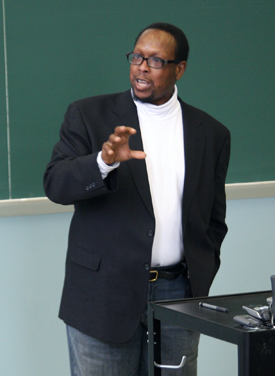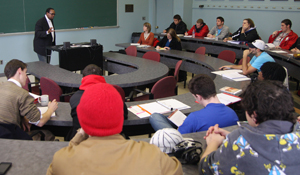How do Malcolm X, Facebook, and Muhammad Ali relate to each other?
Before the 21st century, the question would have been difficult to answer. But with the rise of social networking, Mark Anthony Neal, Professor of Black Popular Culture at Duke University, has been able to revisit the history of black social and political figures like Malcolm X, Sam Cooke, Muhammad Ali, and Jim Brown within the context of modern-day possibilities for communication.
 Neal has been on campus since Wednesday as the College’s Owen Duston Visiting Minority Scholar. He has visited nearly half a dozen classes, and faculty, staff, and students have been holding weekly round table discussions of Neal’s book New Black Man in preparation for his visit. He delivered the annual Malcolm X Institute Lecture Thursday on the friendships among different civil rights leaders in the mid-20th century and how those friendships could form and mean today.
Neal has been on campus since Wednesday as the College’s Owen Duston Visiting Minority Scholar. He has visited nearly half a dozen classes, and faculty, staff, and students have been holding weekly round table discussions of Neal’s book New Black Man in preparation for his visit. He delivered the annual Malcolm X Institute Lecture Thursday on the friendships among different civil rights leaders in the mid-20th century and how those friendships could form and mean today.
Neal told the story of how four men were brought together by their mutual relationships with Muhammad Ali and divided by the vicissitudes of life and politics in the 1960s.
Malcolm X was a social theorist political activist representing a fringe element of the civil rights movement.
Sam Cooke was an R&B singer and entrepreneur.
Jim Brown was a professional football player and actor, perhaps best known for the records he set as running back for the Cleveland Browns back in the 1950s and 1960s.
And Cassius Clay, who later changed his name to Muhammad Ali, was a famous – or infamous – boxer known for saying whatever came to his mind.
Neal panned the unique bond of this “quartet,” how it developed and what possibilities could have arisen out of their continued friendship.
“One reason we’ll never know how this friendship developed is because three weeks [after they all spent time together in Miami] Malcolm X leaves the Nation of Islam,” Neal said. “A day [later] Muhammad Ali announces to the world that he’s no longer Cassius Clay…and is instructed to sever all ties with Malcolm X. I often wonder what might have happened to that relationship if, in the face of all this public stuff, Ali and Malcolm X could have texted each other, if they had had Twitter or Tyspace or Facebook or a way to communicate outside of the public.”
Neal used the example to explore what he calls the “intimacies of everyday life” about which most people are unaware. He challenged the audience to question what goes on behind the scenes among well-known figures today.
 “What might that gang of four look like in 2010?,” Neal asked. "Do we know what kind of conversations Jay-Z and LeBron James and Will Smith might be having in their texts that they may not articulate in public forums?”
“What might that gang of four look like in 2010?,” Neal asked. "Do we know what kind of conversations Jay-Z and LeBron James and Will Smith might be having in their texts that they may not articulate in public forums?”
One example he used was financial relationship between Will and Jada Smith and Jay-Z, who tend to invest in the similar enterprises like plays and start-up businesses.
“We have a kind of nostalgia for that [60s] generation of men and so we think this generation of men and women could never be as influential as a Malcolm X or Muhammad Ali or Sam Cooke or Jim Brown. But I say go back to how many in this country thought about Muhammad Ali in 1961 and 1962.”
Neal also took questions from the audience on contemporary figures like Kanya West and what they mean within the context he had constructed, but, as the conversation was winding down, he asked audience members to think about how figures like Tiger Woods, Michael Jordan, and others are comparatively silent on national political issues in public, but what social networking may allow them that it could not offer those who came before them.
Photos by Alex Moseman '11